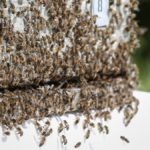Do honey bees migrate? Short answer. Yes. Long answer -the rest of this article!! Let us take a look at the different ways bees can migrate. Migration can be loosely defined as a seasonal movement of a creature/s from one place to another. These migrations can be triggered by changing seasons, drought, fire, starvation, and various other factors which force movement.
Swarms – A Form Of Seasonal Migration
If we look at a spring swarm, these bees leave the parent hive and fly a certain distance before they settle and build a new hive. This is seasonal migration, with bees seeking new territory to work in. A swarm of bees can move quite large distances.
When a swarm takes to the air from a parent hive, it will normally settle quite close to the hive in a bush. The next day, that swarm will fly as far as 5-20 miles depending on the race of the bee. I have spoken to researchers who have documented bees moving as far as 100 miles in a series of flights over a week. These bees were moving in search of forage and had to migrate from one forest to another over an arid grassland.
In dry regions, these migrations are especially important. The fascinating Sahara bee must spread from oasis to oasis using this method. So…do honey bees migrate? Yes, by swarming!
Absconding
Absconding is another form of migration. Sometimes if bees run out of stores during a dry warm period they will just leave the hive and go somewhere else. This is particularly common with African bee races. During the rainy season there is an abundance of sustenance and swarms move into many locations. As the dry season approaches, swarms can starve and move back to areas with permanent water and better nectar.
When bees abscond, they abandon the hive and leave all the comb, and even some brood and stores behind. This can be very disheartening for a beekeeper.
Learn more about: What Time Of Day Do Bees Swarm?
Actual Seasonal Migration
The giant relative of our honeybee, Apis dorsata, is believed to migrate. These bees are very big and build nests that hang from branches, cliffs, and buildings. In parts of India, there are records of seasonal migration of these bees into the colder regions. In summer the bees thrive here and then migrate back down to the warmer plains for winter. They struggle to adapt to colder weather because their hives are open to the environment.
I have witnessed this migration, and it is quite incredible. Apis dorsata are just amazing bees. They often nest in colonies of hundreds of swarms hanging from a big teak tree or water tower. The combs can hang more than 6ft from the surface, and hives can have 100’s of thousands of bees in a swarm. When these bees swarm they have a deep rumble like a bus. A very different sound to an Apis mellifera swarm.
When Do Bees Go Away?
Bees will leave an area if it has no flowers. If a hive eats its honey reserves, and no flowers are available to provide sustenance, they will abscond. I have seen this happen in some areas where farmers kept burning land to encourage grass. The heavy burning regime destroyed the flowers and bees starved and left.
I have also seen bees leave an area during extreme droughts when plants literally shut down or die from lack of rain. This is an increasing problem globally with climate change and increase dry cycles.
Bees will also leave if it gets too hot – if air temperatures exceed human body temperature for days at a time, bees can start to accumulate hive damage. Eventually, they will abscond looking for a cooler place to nest. Often, these swarms migrate up mountains attempting to find cooler areas to nest in.

Do Bees Hibernate Or Migrate?
Certain races of bees can enter a state of winter survival termed a winter cluster. This is not hibernation, as that is a metabolic trick reserved for warm-blooded mammals. However, it is a state that allows bees to survive cold icy winters.
When a winter cluster forms, the bees huddle together and slowly consume honey stores. They generate a little bit of heat and move around to keep alive. In this regard, they do reduce their metabolic activity to conserve energy. This is not the same as hibernation.
This does mean however that if you are in a colder region of the world, there will be multiple months in the year when it is too cold for bees to fly. They have not left – they are just overwintering, and will reappear in spring.
When Do Bees Go Away?
As we have mentioned earlier, bees go away by absconding if conditions are not favorable. They will also stop flying when it gets very cold and under such conditions, they appear to have gone away. They are in fact just overwintering and will reappear in spring.
There are other conditions in which bees will go away. If a beehive is robbed of its brood nest by a human or a predator this will result in the bees absconding. Normally. They will abandon the area where their hive was and seek a nice location. This can be a major source of swarms that move around in parts of the world with honey badgers. In central African woodlands, honeybadgers frequently destroy hives and these hives abscond and find new nesting locations.
I have spoken to beekeepers in these regions who place badger-proof hives and rely on these swarms to populate their hives. Honey badgers are an important, but irritating part of the beekeeping cycle in much of Africa. This is similar to the role played by bears in Eurasia and North America.
Read more about: When Do Bees Go Away?
So to answer the question “Do Honey bees migrate” once and for all – yes they do! But it’s complicated. I hope you enjoyed this article and if you did, please share.
Bee Seasonal Behavior FAQs
Do honey bees migrate?
Yes, honey bees do migrate, but their movement is often seasonal and influenced by environmental changes. Migration can occur through swarming, absconding, or in response to food scarcity.
What is swarming, and how is it related to bee migration?
Swarming is a form of seasonal migration where a portion of the bee colony leaves the hive to find a new location. It usually happens in spring when bees seek new areas to forage and build a new hive.
What triggers bee migration through absconding?
Absconding occurs when bees abandon their hive due to unfavorable conditions, like a lack of food, water, or extreme temperatures. This form of migration is common among African bee species.
How far can bees migrate when they swarm?
Bees can travel anywhere from 5 to 100 miles when they swarm, depending on environmental factors and bee species. Some researchers have documented bees moving over long distances in search of better foraging areas.
Do honey bees hibernate or migrate in winter?
Honey bees don’t hibernate but form a “winter cluster” to survive cold months. They conserve energy by huddling together and slowly consuming honey stores until spring.
What role does climate change play in bee migration?
Climate change affects bee migration by increasing the frequency of droughts, temperature extremes, and altering the availability of flowers, which forces bees to migrate in search of better habitats.
Do bees migrate up mountains during hot weather?
Yes, when temperatures rise excessively, bees may migrate to cooler areas such as mountainous regions to avoid heat stress and find more suitable nesting locations.
Can bees migrate due to predatory threats?
Yes, bees will abscond if their hive is threatened by predators like honey badgers or bears. This forced migration often leads them to find safer nesting locations.
Do all bee species migrate in the same way?
No, different bee species migrate differently. For instance, Apis dorsata, a giant bee species, is known to migrate seasonally between colder and warmer regions.
How does absconding affect beekeepers?
Absconding can be frustrating for beekeepers as bees leave behind their hive, comb, and sometimes brood. It often results in beekeepers losing their colonies if conditions aren’t optimal for bee survival.

Dr. Garth A. Cambray is a Canadian/South African entrepreneur and beekeeper with 28 years of experience in apiculture and specializes in adding value to honey. His Ph.D. research developed a new advanced continuous fermentation method for making mead that has resulted in a number of companies globally being able to access markets for mead. His company, Makana Meadery, exports honey mead to the USA where it is available to discerning connoisseurs. He has also developed technologies to commercially manufacture organic honey vinegar in Zambia for export globally. He holds a few patents globally in the ethanol industry and believes in technology and knowledge transfer for human development and environmental sustainability. One of his proudest achievements is the fact that the wind farm he started at one of his old apiary sites has essentially made his hometown carbon neutral.






